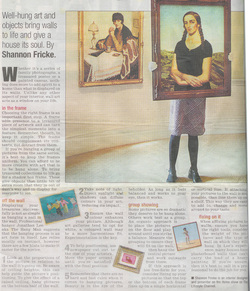The Sunday Telegraph - Around the House - 1 August 2004

Well-hung art and objects bring walls to life and give a house its soul. By Shannon Fricke.
Whether it’s a series of family photographs, a treasured poster or a painted canvas, nothing does more to add spirit to a home than what is displayed on its walls. Unlike any other aspect of your interior, wall art acts as a window on your life.
Off the wall
Displaying your treasures successfully is not as simple as banging a nail in the wall. Professional hanger Jonathon Lee aka The Hangman suggests that the hanging process is an art form in itself. Lee relies mostly on instinct, however there are a few hints to make it easier for the novice.
1. Look at the proportions of the picture in relation to the wall it’s going on. Be aware of ceiling heights; this can help guide the picture’s positioning. To give the effect of a raised ceiling, hang pictures on the bottom half of the wall.
2. Take note of light. Direct sunlight and shadows can diffuse colours in your art, reducing its impact.
3. Ensure the wall colour enhances your picture. Although art galleries tend to opt for white, a coloured wall may be a more harmonious fit. Experimentation is the key.
4. To help positioning, use newspaper cut out to the size of your artwork. Move the paper around until you are satisfied with the final position.
5. Remember that there are no hard and fast rules when it comes to hanging pictures. Beauty is in the eye of the beholder. As long as it feels balanced and works to your eye, then it works.
Group showing
Some pictures are so dramatic they deserve to be hung alone. Others work best as a group. An organic approach is to place the pictures on the floor and play around until you strike a balance. Measure the grouping to ensure they will fit on the wall, then hang the central picture and work outwards from there.
If this approach is too free-form for you, consider lining up your pictures so that the top or the bottom of each frame lines up on a single horizontal or vertical line. If attaching your pictures to the wall is not possible, then line them up on a shelf. This way they are easy to add to, change and move around to your taste.
Fixing on it
When affixing pictures to walls, ensure you have the right tools, consider the weight of the pictures and the type of wall on which they will hang. In Lee’s experience, many houses have plasterboard walls that can’t carry the load of a heavy painting. If you’re unsure, then it’s best to call in a professional to do the job for you.
Whether it’s a series of family photographs, a treasured poster or a painted canvas, nothing does more to add spirit to a home than what is displayed on its walls. Unlike any other aspect of your interior, wall art acts as a window on your life.
Off the wall
Displaying your treasures successfully is not as simple as banging a nail in the wall. Professional hanger Jonathon Lee aka The Hangman suggests that the hanging process is an art form in itself. Lee relies mostly on instinct, however there are a few hints to make it easier for the novice.
1. Look at the proportions of the picture in relation to the wall it’s going on. Be aware of ceiling heights; this can help guide the picture’s positioning. To give the effect of a raised ceiling, hang pictures on the bottom half of the wall.
2. Take note of light. Direct sunlight and shadows can diffuse colours in your art, reducing its impact.
3. Ensure the wall colour enhances your picture. Although art galleries tend to opt for white, a coloured wall may be a more harmonious fit. Experimentation is the key.
4. To help positioning, use newspaper cut out to the size of your artwork. Move the paper around until you are satisfied with the final position.
5. Remember that there are no hard and fast rules when it comes to hanging pictures. Beauty is in the eye of the beholder. As long as it feels balanced and works to your eye, then it works.
Group showing
Some pictures are so dramatic they deserve to be hung alone. Others work best as a group. An organic approach is to place the pictures on the floor and play around until you strike a balance. Measure the grouping to ensure they will fit on the wall, then hang the central picture and work outwards from there.
If this approach is too free-form for you, consider lining up your pictures so that the top or the bottom of each frame lines up on a single horizontal or vertical line. If attaching your pictures to the wall is not possible, then line them up on a shelf. This way they are easy to add to, change and move around to your taste.
Fixing on it
When affixing pictures to walls, ensure you have the right tools, consider the weight of the pictures and the type of wall on which they will hang. In Lee’s experience, many houses have plasterboard walls that can’t carry the load of a heavy painting. If you’re unsure, then it’s best to call in a professional to do the job for you.